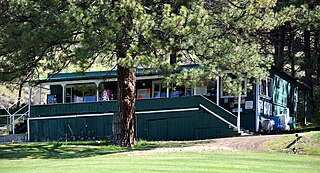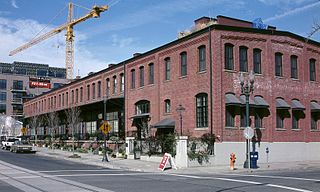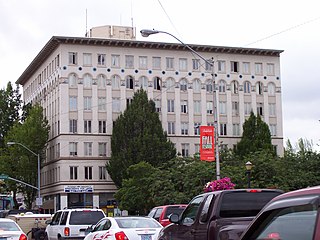The Pearl District is an area of Portland, Oregon, formerly occupied by warehouses, light industry and railroad classification yards and now noted for its art galleries, upscale businesses and residences. The area has been undergoing significant urban renewal since the mid-1980s when it was reclassified as mixed use from industrial, including the arrival of artists, the removal of a viaduct and construction of the Portland Streetcar. It now consists of industrial building conversion to offices, high-rise condominiums and warehouse-to-loft conversions.

A warehouse is a building for storing goods. Warehouses are used by manufacturers, importers, exporters, wholesalers, transport businesses, customs, etc. They are usually large plain buildings in industrial parks on the outskirts of cities, towns, or villages.

The Oregon Historical Society(OHS) is an organization that encourages and promotes the study and understanding of the history of the Oregon Country, within the broader context of U.S. history. Incorporated in 1898, the Society collects, preserves, and makes available materials of historical character and interest, and collaborates with other groups and individuals with similar aims. The society operates the Oregon History Center that includes the Oregon Historical Society Museum in downtown Portland.

The Meier & Frank Building is a fifteen-story, glazed terra cotta building located in downtown Portland, Oregon, across from the northeast corner of Pioneer Courthouse Square. The building is the former flagship store and headquarters building for the Meier & Frank department store chain, which was taken over by Macy's in 2006. In 2006–2007, the building's lower floors were remodeled into an updated Macy's department store, while the upper floors were renovated in 2008 into a luxury hotel known as The Nines. In 2016, Macy's announced that it planned to close the store in spring 2017, and the store closed in April 2017.

Self storage is an industry that rents storage space, also known as "storage units," to tenants, usually on a short-term basis. Self-storage tenants include businesses and individuals.
Microcosm Publishing is an independent publisher and distributor based in Portland, Oregon. Microcosm describes itself as having "a reputation for teaching self-empowerment, showing hidden histories, and fostering creativity through challenging conventional publishing wisdom, influencing other publishers large and small with books and bookettes about DIY skills, food, zines, and art."

Market of Choice is a supermarket chain based in Eugene, Oregon, United States. The store carries conventional groceries, as well as natural and organic products.

Camera World was a retailer of photographic equipment and photofinishing services based in Portland, Oregon, United States, and founded in 1977. It was an independent company until 2002, and then from 2002 to 2016 it was a brand of Ritz Camera & Image or C&A Marketing. In the mid-1990s, it was one of the largest mail-order retailers of photographic and audio equipment in the nation. The company's revenues totalled $80 million in 1998, of which $16 million were from online sales. Revenues grew to $115.7 million in 1999, and the company relocated its administrative offices and inventory to a new facility in Beaverton, Oregon, the following year. The company's only brick-and-mortar store, in downtown Portland, as well as its Internet business were sold in 2002 to Ritz Camera, which continued to operate them under the Camera World name. Ritz, in turn, was acquired by C&A Marketing in 2012, but retained the Camera World name as a Ritz brand, for both the store and the Internet business, until closure of the store. The store closed on January 21, 2016.
US Foods CHEF'STORE is a chain of American warehouse grocery stores located in Arizona, California, Idaho, Montana, Nevada, North Carolina, Oklahoma, Oregon, South Carolina, Texas, Utah, Virginia, and Washington. The company operates 88 stores at the end of February 2023. One store in Arizona, 17 in California, 6 in Idaho, three in Montana, two in Nevada, two stores in North Carolina, one in Oklahoma, 21 in Oregon, four stores in South Carolina, one in Texas, two in Utah, one in Virginia, and 27 stores in Washington state. The company is based in West Linn, Oregon, and Rosemont, Illinois.
Pine Grove is an unincorporated community in Hood River County, Oregon, United States on Oregon Route 35 in the middle Hood River Valley near Neal Creek. It is about five miles south of the city of Hood River and has a Hood River ZIP code.

Kinzua is a ghost town or former town site in Wheeler County, Oregon, United States. It existed as a company town from 1927 to 1978. Kinzua lies directly east of Fossil and uses a Fossil mailing address.
Chesterfield is a ghost town in Caribou County, Idaho, United States. It is located in Gem Valley at an elevation of 5,446 feet (1,660 m). The community includes a cemetery and former buildings of the Church of Jesus Christ of Latter-day Saints such as a former meeting house, amusement hall and tithing house.

Montgomery Park is an office building and former Montgomery Ward mail-order catalog warehouse and department store located in Portland, Oregon, United States, built in 1920. It is listed on the National Register of Historic Places under its historic name Montgomery Ward & Company Building. The building is located on property once used for the Lewis and Clark Centennial Exposition, of 1905. It was occupied by Montgomery Ward from 1920 until 1985, although the majority of the company's operations at this location ended in 1982. The building is the second-largest office building in Portland with 577,339 square feet (53,636.5 m2).

The North Bank Depot Buildings, in central Portland, Oregon, United States, are a pair of buildings formerly used as a freight warehouse and passenger terminal for the Spokane, Portland and Seattle Railway (SP&S). Formed in 1905, the SP&S was commonly known as the North Bank Road during the period in which these buildings were in use. The Portland buildings' passenger facilities were also used by the Oregon Electric Railway after that railway was acquired by the SP&S. Located in what is now known as the Pearl District, the buildings were listed on the National Register of Historic Places in 1996. They were in use by the SP&S and its successor, Burlington Northern Railroad, from 1908 until the 1980s. Only the east building was used as a passenger station, and this usage lasted from 1908 until 1931.

The Blake McFall Company Building, also known as the Emmett Building, in southeast Portland in the U.S. state of Oregon, is a five-story commercial warehouse listed on the National Register of Historic Places. Designed by McNaughton & Raymond of Portland and built in 1915, it was added to the register in 1990. The 100-by-200-foot structure is representative of a group of timber-framed loft warehouses built in the early 20th century on the east side of the Willamette River.

The Portland General Electric Company Station "L" Group in southeast Portland in the U.S. state of Oregon was a cluster of six industrial buildings listed on the National Register of Historic Places. Built between 1910 and 1929 by Portland General Electric (PGE), it was added to the register in 1985. In 1986, PGE gave Station L and 18.5 acres (7.5 ha) of land to the Oregon Museum of Science and Industry (OMSI). The Station L turbine is a central feature of OMSI's Turbine Hall. The complex was listed on the National Register in 1985, and was delisted in 2020.

Houghtaling & Dougan was an American architectural firm based in Oregon. It was a partnership of Chester A. Houghtaling and Luther Lee Dougan. A number of their works are listed on the U.S. National Register of Historic Places (NRHP).

The Dalles Mint was to be a branch of the United States Mint in The Dalles in Oregon. Partially constructed in 1869, the planned two-story structure was never completed and the mint was never put into operation. Located in the downtown area of the city, the building was given to the state before it was sold to the public. The Mint building was most recently home to the Erin Glenn Winery.

Claussen and Claussen was an architecture firm based in Portland, Oregon, that designed several prominent buildings in the first half of the 20th century. Some of the buildings have been added to the National Register of Historic Places, including the Roosevelt Hotel, the Park Heathman Hotel, the Loyalty Building, Ira Powers Warehouse, and Portland Van and Storage.

The Howard Hardware Storehouse is a historic storage building off Bridge Street in Bellows Falls, Vermont. Built about 1895, it is a surviving reminder of the city's railroad-related economic past, built in a distinctive tetrahedral shape to accommodate nearby railroad lines. It was listed on the National Register of Historic Places in 1990.















